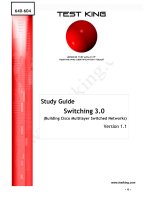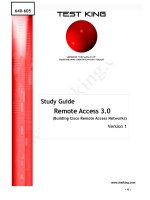CMMI - Version 1.2 Overview07
Bạn đang xem bản rút gọn của tài liệu. Xem và tải ngay bản đầy đủ của tài liệu tại đây (599.81 KB, 41 trang )
© 2007 Carnegie Mellon University
Capability Maturity Model®
Integration (CMMI®) Version
1.2 Overview
SM
CMM Integration, IDEAL, Personal Software Process, PSP, SCAMPI, SCAMPI Lead Appraiser,
Team Software Process, and TSP are service marks of Carnegie Mellon University.
® Capability Maturity Model, Capability Maturity Modeling, Carnegie Mellon, CMM, and CMMI are
registered in the US Patent and Trademark Office by Carnegie Mellon University.
For more information on CMU/SEI trademark use, please visit
/>2
SEI Presentation (Full Color)
Author, Date
© 2007 Carnegie Mellon University
Topics
Common Process Problems
Process Improvement Basics
Process Models
The CMMI Concept
Appraisals and Training
The Benefits of Using CMMI
CMMI Adoption
The Bottom Line
<
3
SEI Presentation (Full Color)
Author, Date
© 2007 Carnegie Mellon University
Settling for Less
Do these statements sound familiar? If they do, your organization may be
settling for less than it is capable of and may be a good candidate for
process improvement.
“I'd rather have it wrong than have it late. We can always fix it later.”
– a senior software manager (industry)
“The bottom line is schedule. My promotions and raises are based on
meeting schedule first and foremost.”
– a program manager (government)
4
SEI Presentation (Full Color)
Author, Date
© 2007 Carnegie Mellon University
Symptoms of Process Failure
Commitments consistently missed
• Late delivery
• Last minute crunches
• Spiraling costs
No management visibility into progress
• You’re always being surprised
Quality problems
• Too much rework
• Functions do not work correctly
• Customer complaints after delivery
Poor morale
• People frustrated
• Is anyone in charge?
5
SEI Presentation (Full Color)
Author, Date
© 2007 Carnegie Mellon University
Topics
Common Process Problems
Process Improvement Basics
Process Models
The CMMI Concept
Appraisals and Training
The Benefits of Using CMMI
CMMI Adoption
The Bottom Line
<
6
SEI Presentation (Full Color)
Author, Date
© 2007 Carnegie Mellon University
The Process Management Premise
The quality of a system is highly influenced by
the quality of the process used to acquire, develop,
and maintain it.
This premise implies a focus on processes as well
as on products.
• This is a long-established premise in manufacturing (and is based on TQM
principles as taught by Shewhart, Juran, Deming, and Humphrey).
• Belief in this premise is visible worldwide in quality movements in
manufacturing and service industries
(e.g., ISO standards).
7
SEI Presentation (Full Color)
Author, Date
© 2007 Carnegie Mellon University
Quality Leverage Points
While process is often described as a node of the process-people-
technology triad, it can also be considered the “glue” that ties the triad
together.
PEOPLE
PROCESS
TECHNOLOGY
Everyone realizes the
importance of having a
motivated, quality work force
but even our finest people
cannot perform at their best
when the process is not
understood or operating at its
best.
Process, people, and technology are the major determinants
of product cost, schedule, and quality.
8
SEI Presentation (Full Color)
Author, Date
© 2007 Carnegie Mellon University
Common Misconceptions
I don’t need process, I have
• really good people
• advanced technology
• an experienced manager
Process
• interferes with creativity
• equals bureaucracy + regimentation
• isn’t needed when building prototypes
• is only useful on large projects
• hinders agility in fast-moving markets
• costs too much
9
SEI Presentation (Full Color)
Author, Date
© 2007 Carnegie Mellon University
Topics
Common Process Problems
Process Improvement Basics
Process Models
The CMMI Concept
Appraisals and Training
The Benefits of Using CMMI
CMMI Adoption
The Bottom Line
<
10
SEI Presentation (Full Color)
Author, Date
© 2007 Carnegie Mellon University
What Is a Process Model?
A process model is a structured collection of practices that describe the
characteristics of effective processes.
Practices included are those proven by experience to be effective.
11
SEI Presentation (Full Color)
Author, Date
© 2007 Carnegie Mellon University
How Is a Process Model Used?
A process model is used
• to help set process improvement objectives and priorities
• to help ensure stable, capable, and mature processes
• as a guide for improvement of project and organizational processes
• with an appraisal method to diagnose the state of an organization’s current
practices
12
SEI Presentation (Full Color)
Author, Date
© 2007 Carnegie Mellon University
Why Is a Process Model Important?
A process model provides
• a place to start improving
• the benefit of a community’s prior experiences
• a common language and a shared vision
• a framework for prioritizing actions
• a way to define what improvement means for an organization
13
SEI Presentation (Full Color)
Author, Date
© 2007 Carnegie Mellon University
Topics
Common Process Problems
Process Improvement Basics
Process Models
The CMMI Concept
Appraisals and Training
The Benefits of Using CMMI
CMMI Adoption
The Bottom Line
<
14
SEI Presentation (Full Color)
Author, Date
© 2007 Carnegie Mellon University
CMMI for Process Improvement -1
Use CMMI in process improvement activities as a
• collection of best practices
• framework for organizing and prioritizing activities
• support for the coordination of multi-disciplined activities that might be
required to successfully build a product
• means to emphasize the alignment of the process improvement objectives
with organizational business objectives
CMMI incorporates lessons learned from use of the SW-CMM
®
, EIA-731,
and other standards and models.
15
SEI Presentation (Full Color)
Author, Date
© 2007 Carnegie Mellon University
CMMI for Process Improvement -2
A CMMI model is not a process.
A CMMI model describes the
characteristics of effective
processes.
“All models are wrong,
but some are useful.”
George Box
(Quality and Statistics
Engineer)
16
SEI Presentation (Full Color)
Author, Date
© 2007 Carnegie Mellon University
The CMMI Framework
The CMMI Framework is the structure that organizes the components
used in generating models, training materials, and appraisal methods.
The CMMI Product Suite is the full collection of models, training materials,
and appraisal methods generated from the CMMI Framework.
The components in the CMMI Framework are organized into groupings,
called
constellations, which facilitate construction of approved models.
• During v1.2 development, CMMI-SE/SW/IPPD/SS was moved to the CMMI
for Development (CMMI-DEV) constellation.
• Two new constellations have been commissioned by CMMI Steering
Group:
— CMMI for Services (CMMI-SVC)
— CMMI for Acquisition (CMMI-ACQ)









